MGMT1102 Corporate Social Responsibility Exam: Winter 2019 Edition
VerifiedAdded on 2023/04/21
|8
|1958
|89
Essay
AI Summary
This essay provides solutions to questions related to corporate social responsibility, addressing responsiveness in the age of responsibility with examples of companies like Walmart and Eco-Patent Commons, and discussing the trade-off between responsiveness and scalability. It also defines glocality, applying the concept to the car industry with examples like Starbucks in China and the UK, and highlights the benefits of glocalization for businesses. Furthermore, the essay examines how human bias affects environmental and social impacts, proposing strategies, based on behavioral economics, to nudge consumers towards sustainability, such as providing knowledge, making sustainability easy and enjoyable, and using visual representations and scarcity principles. The essay concludes by emphasizing the importance of stakeholder involvement and making sustainable options the default choice.
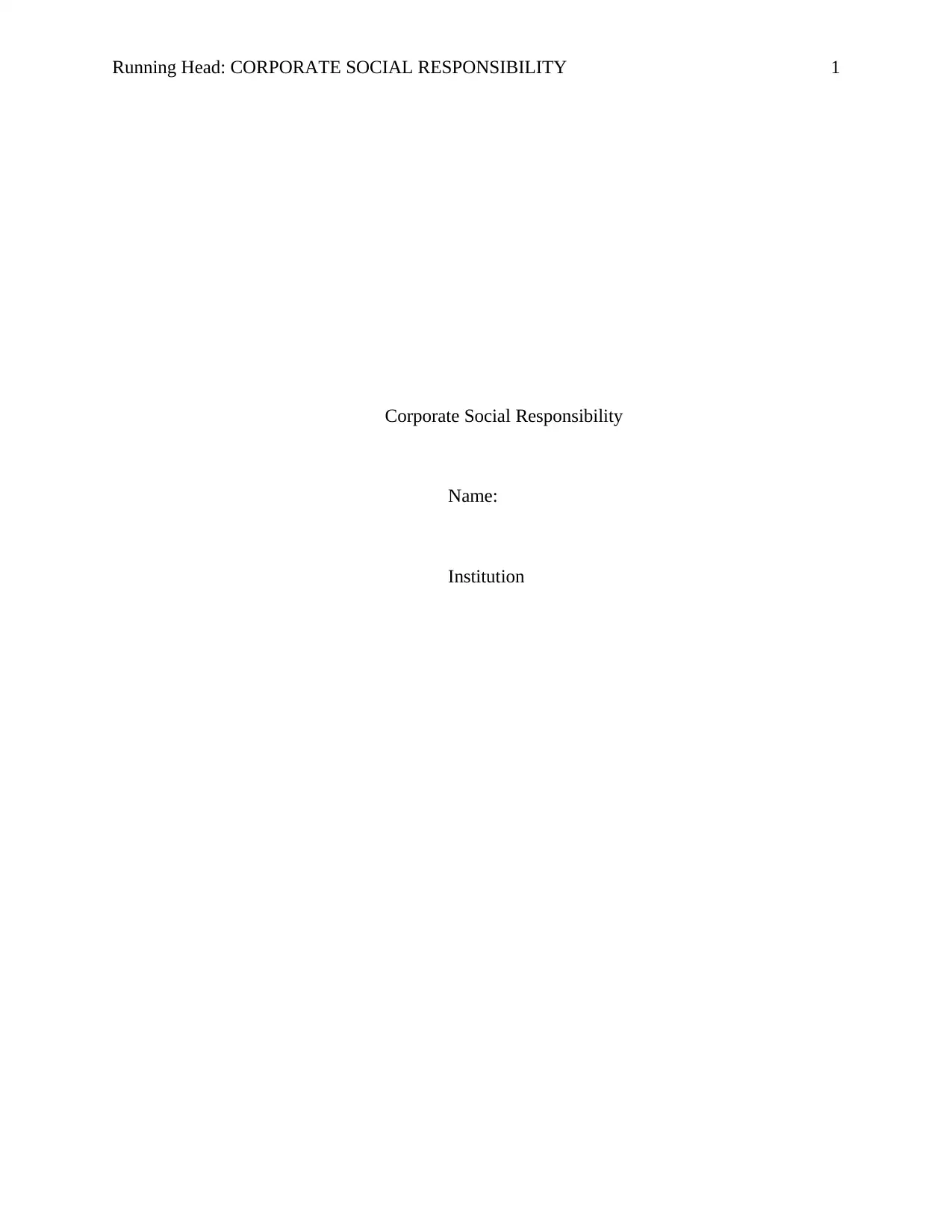
Running Head: CORPORATE SOCIAL RESPONSIBILITY 1
Corporate Social Responsibility
Name:
Institution
Corporate Social Responsibility
Name:
Institution
Paraphrase This Document
Need a fresh take? Get an instant paraphrase of this document with our AI Paraphraser
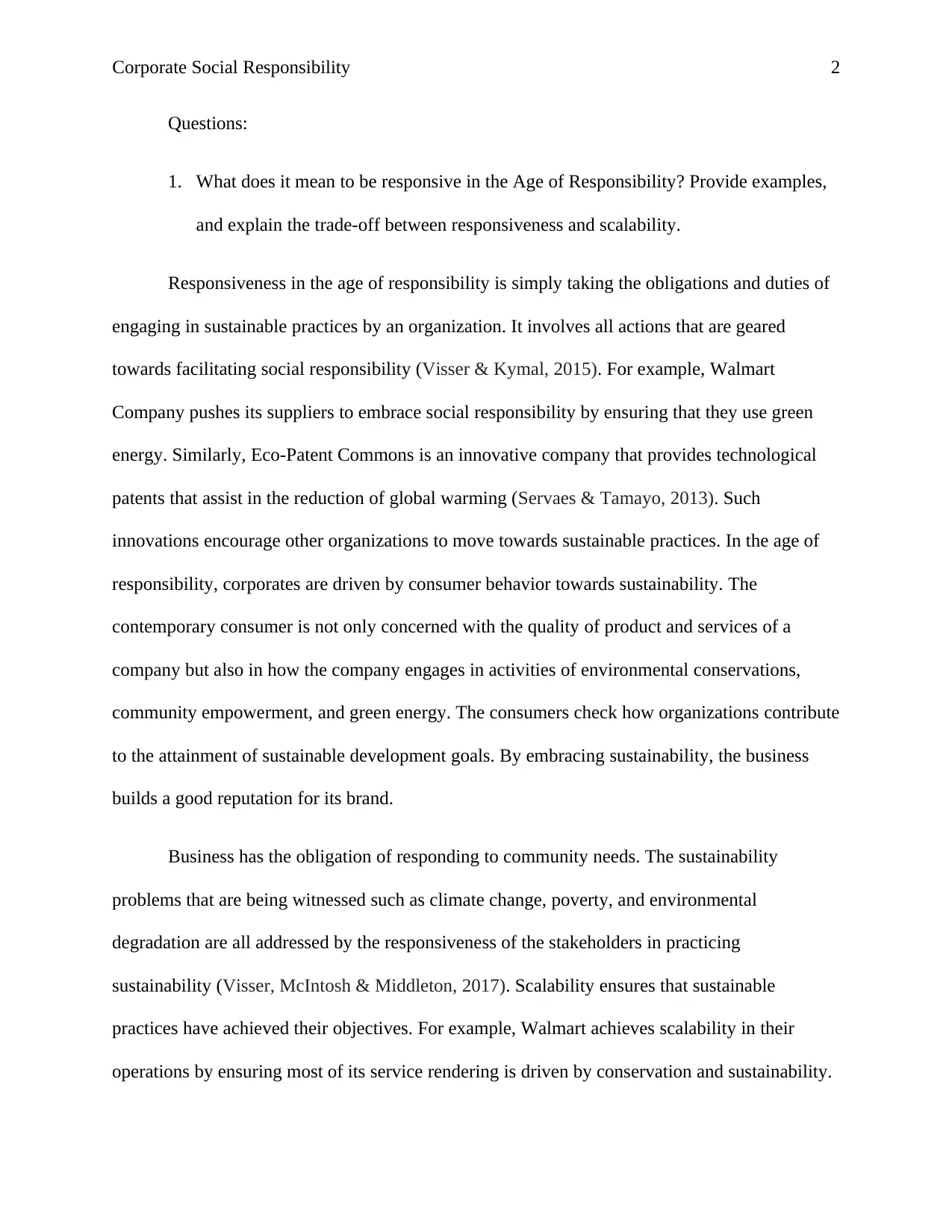
Corporate Social Responsibility 2
Questions:
1. What does it mean to be responsive in the Age of Responsibility? Provide examples,
and explain the trade-off between responsiveness and scalability.
Responsiveness in the age of responsibility is simply taking the obligations and duties of
engaging in sustainable practices by an organization. It involves all actions that are geared
towards facilitating social responsibility (Visser & Kymal, 2015). For example, Walmart
Company pushes its suppliers to embrace social responsibility by ensuring that they use green
energy. Similarly, Eco-Patent Commons is an innovative company that provides technological
patents that assist in the reduction of global warming (Servaes & Tamayo, 2013). Such
innovations encourage other organizations to move towards sustainable practices. In the age of
responsibility, corporates are driven by consumer behavior towards sustainability. The
contemporary consumer is not only concerned with the quality of product and services of a
company but also in how the company engages in activities of environmental conservations,
community empowerment, and green energy. The consumers check how organizations contribute
to the attainment of sustainable development goals. By embracing sustainability, the business
builds a good reputation for its brand.
Business has the obligation of responding to community needs. The sustainability
problems that are being witnessed such as climate change, poverty, and environmental
degradation are all addressed by the responsiveness of the stakeholders in practicing
sustainability (Visser, McIntosh & Middleton, 2017). Scalability ensures that sustainable
practices have achieved their objectives. For example, Walmart achieves scalability in their
operations by ensuring most of its service rendering is driven by conservation and sustainability.
Questions:
1. What does it mean to be responsive in the Age of Responsibility? Provide examples,
and explain the trade-off between responsiveness and scalability.
Responsiveness in the age of responsibility is simply taking the obligations and duties of
engaging in sustainable practices by an organization. It involves all actions that are geared
towards facilitating social responsibility (Visser & Kymal, 2015). For example, Walmart
Company pushes its suppliers to embrace social responsibility by ensuring that they use green
energy. Similarly, Eco-Patent Commons is an innovative company that provides technological
patents that assist in the reduction of global warming (Servaes & Tamayo, 2013). Such
innovations encourage other organizations to move towards sustainable practices. In the age of
responsibility, corporates are driven by consumer behavior towards sustainability. The
contemporary consumer is not only concerned with the quality of product and services of a
company but also in how the company engages in activities of environmental conservations,
community empowerment, and green energy. The consumers check how organizations contribute
to the attainment of sustainable development goals. By embracing sustainability, the business
builds a good reputation for its brand.
Business has the obligation of responding to community needs. The sustainability
problems that are being witnessed such as climate change, poverty, and environmental
degradation are all addressed by the responsiveness of the stakeholders in practicing
sustainability (Visser, McIntosh & Middleton, 2017). Scalability ensures that sustainable
practices have achieved their objectives. For example, Walmart achieves scalability in their
operations by ensuring most of its service rendering is driven by conservation and sustainability.
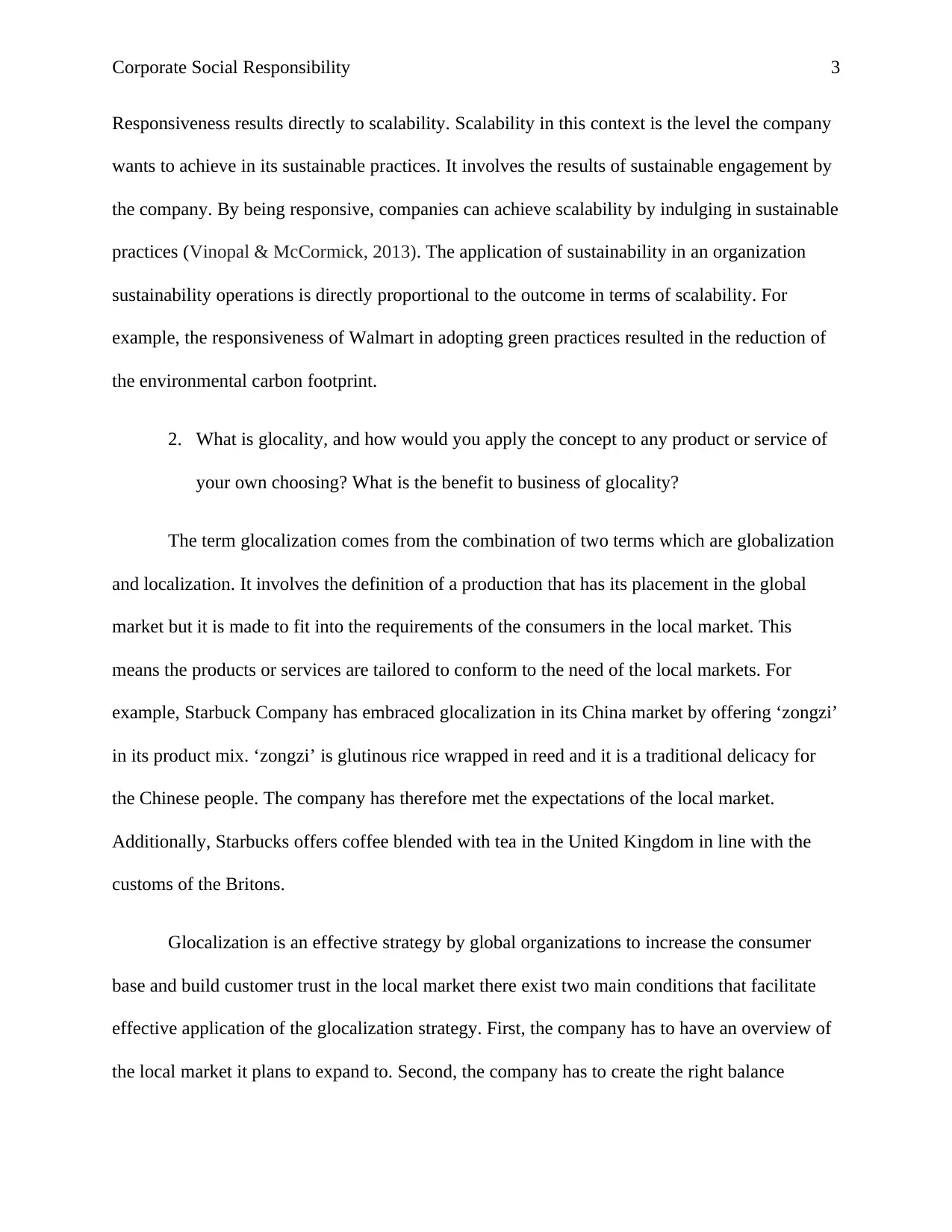
Corporate Social Responsibility 3
Responsiveness results directly to scalability. Scalability in this context is the level the company
wants to achieve in its sustainable practices. It involves the results of sustainable engagement by
the company. By being responsive, companies can achieve scalability by indulging in sustainable
practices (Vinopal & McCormick, 2013). The application of sustainability in an organization
sustainability operations is directly proportional to the outcome in terms of scalability. For
example, the responsiveness of Walmart in adopting green practices resulted in the reduction of
the environmental carbon footprint.
2. What is glocality, and how would you apply the concept to any product or service of
your own choosing? What is the benefit to business of glocality?
The term glocalization comes from the combination of two terms which are globalization
and localization. It involves the definition of a production that has its placement in the global
market but it is made to fit into the requirements of the consumers in the local market. This
means the products or services are tailored to conform to the need of the local markets. For
example, Starbuck Company has embraced glocalization in its China market by offering ‘zongzi’
in its product mix. ‘zongzi’ is glutinous rice wrapped in reed and it is a traditional delicacy for
the Chinese people. The company has therefore met the expectations of the local market.
Additionally, Starbucks offers coffee blended with tea in the United Kingdom in line with the
customs of the Britons.
Glocalization is an effective strategy by global organizations to increase the consumer
base and build customer trust in the local market there exist two main conditions that facilitate
effective application of the glocalization strategy. First, the company has to have an overview of
the local market it plans to expand to. Second, the company has to create the right balance
Responsiveness results directly to scalability. Scalability in this context is the level the company
wants to achieve in its sustainable practices. It involves the results of sustainable engagement by
the company. By being responsive, companies can achieve scalability by indulging in sustainable
practices (Vinopal & McCormick, 2013). The application of sustainability in an organization
sustainability operations is directly proportional to the outcome in terms of scalability. For
example, the responsiveness of Walmart in adopting green practices resulted in the reduction of
the environmental carbon footprint.
2. What is glocality, and how would you apply the concept to any product or service of
your own choosing? What is the benefit to business of glocality?
The term glocalization comes from the combination of two terms which are globalization
and localization. It involves the definition of a production that has its placement in the global
market but it is made to fit into the requirements of the consumers in the local market. This
means the products or services are tailored to conform to the need of the local markets. For
example, Starbuck Company has embraced glocalization in its China market by offering ‘zongzi’
in its product mix. ‘zongzi’ is glutinous rice wrapped in reed and it is a traditional delicacy for
the Chinese people. The company has therefore met the expectations of the local market.
Additionally, Starbucks offers coffee blended with tea in the United Kingdom in line with the
customs of the Britons.
Glocalization is an effective strategy by global organizations to increase the consumer
base and build customer trust in the local market there exist two main conditions that facilitate
effective application of the glocalization strategy. First, the company has to have an overview of
the local market it plans to expand to. Second, the company has to create the right balance
⊘ This is a preview!⊘
Do you want full access?
Subscribe today to unlock all pages.

Trusted by 1+ million students worldwide
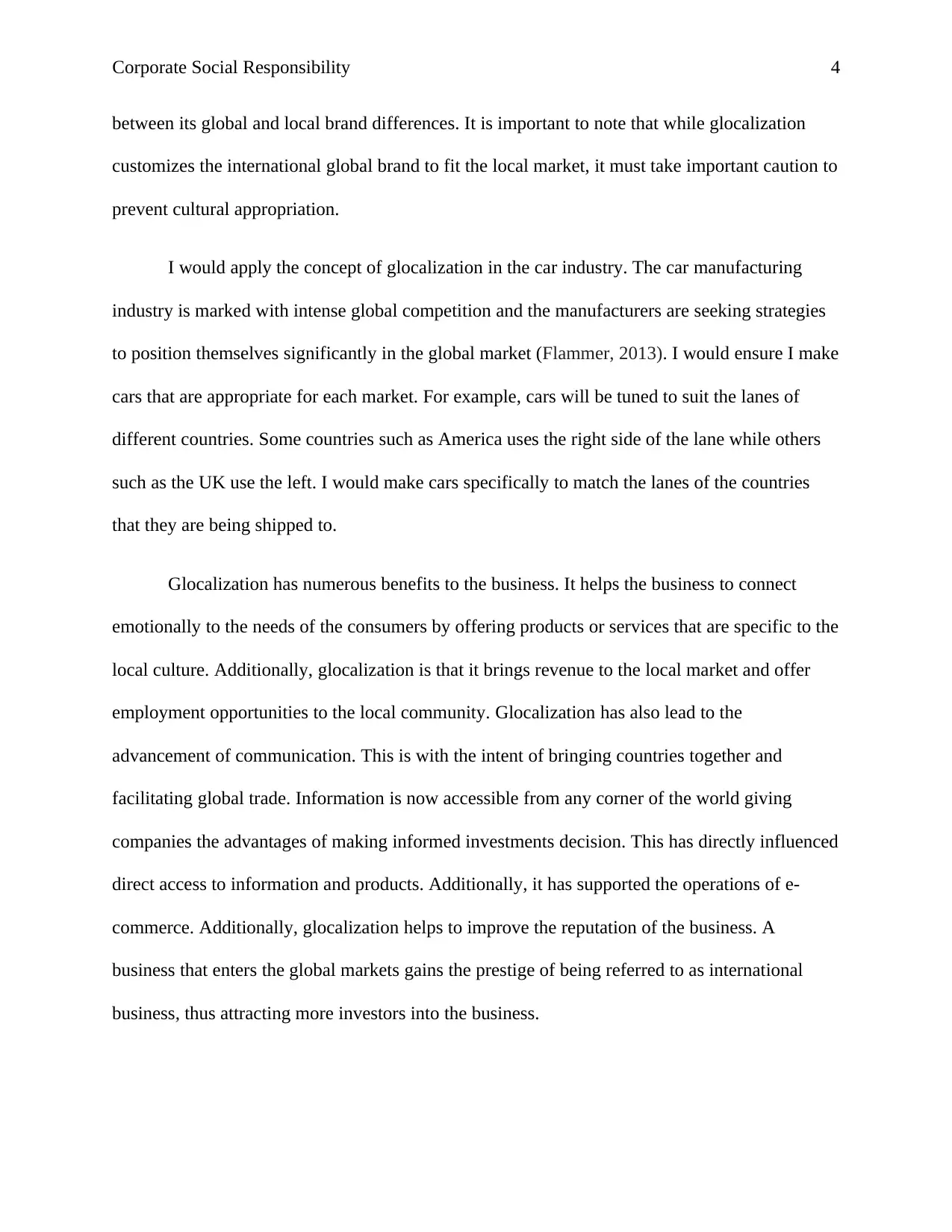
Corporate Social Responsibility 4
between its global and local brand differences. It is important to note that while glocalization
customizes the international global brand to fit the local market, it must take important caution to
prevent cultural appropriation.
I would apply the concept of glocalization in the car industry. The car manufacturing
industry is marked with intense global competition and the manufacturers are seeking strategies
to position themselves significantly in the global market (Flammer, 2013). I would ensure I make
cars that are appropriate for each market. For example, cars will be tuned to suit the lanes of
different countries. Some countries such as America uses the right side of the lane while others
such as the UK use the left. I would make cars specifically to match the lanes of the countries
that they are being shipped to.
Glocalization has numerous benefits to the business. It helps the business to connect
emotionally to the needs of the consumers by offering products or services that are specific to the
local culture. Additionally, glocalization is that it brings revenue to the local market and offer
employment opportunities to the local community. Glocalization has also lead to the
advancement of communication. This is with the intent of bringing countries together and
facilitating global trade. Information is now accessible from any corner of the world giving
companies the advantages of making informed investments decision. This has directly influenced
direct access to information and products. Additionally, it has supported the operations of e-
commerce. Additionally, glocalization helps to improve the reputation of the business. A
business that enters the global markets gains the prestige of being referred to as international
business, thus attracting more investors into the business.
between its global and local brand differences. It is important to note that while glocalization
customizes the international global brand to fit the local market, it must take important caution to
prevent cultural appropriation.
I would apply the concept of glocalization in the car industry. The car manufacturing
industry is marked with intense global competition and the manufacturers are seeking strategies
to position themselves significantly in the global market (Flammer, 2013). I would ensure I make
cars that are appropriate for each market. For example, cars will be tuned to suit the lanes of
different countries. Some countries such as America uses the right side of the lane while others
such as the UK use the left. I would make cars specifically to match the lanes of the countries
that they are being shipped to.
Glocalization has numerous benefits to the business. It helps the business to connect
emotionally to the needs of the consumers by offering products or services that are specific to the
local culture. Additionally, glocalization is that it brings revenue to the local market and offer
employment opportunities to the local community. Glocalization has also lead to the
advancement of communication. This is with the intent of bringing countries together and
facilitating global trade. Information is now accessible from any corner of the world giving
companies the advantages of making informed investments decision. This has directly influenced
direct access to information and products. Additionally, it has supported the operations of e-
commerce. Additionally, glocalization helps to improve the reputation of the business. A
business that enters the global markets gains the prestige of being referred to as international
business, thus attracting more investors into the business.
Paraphrase This Document
Need a fresh take? Get an instant paraphrase of this document with our AI Paraphraser
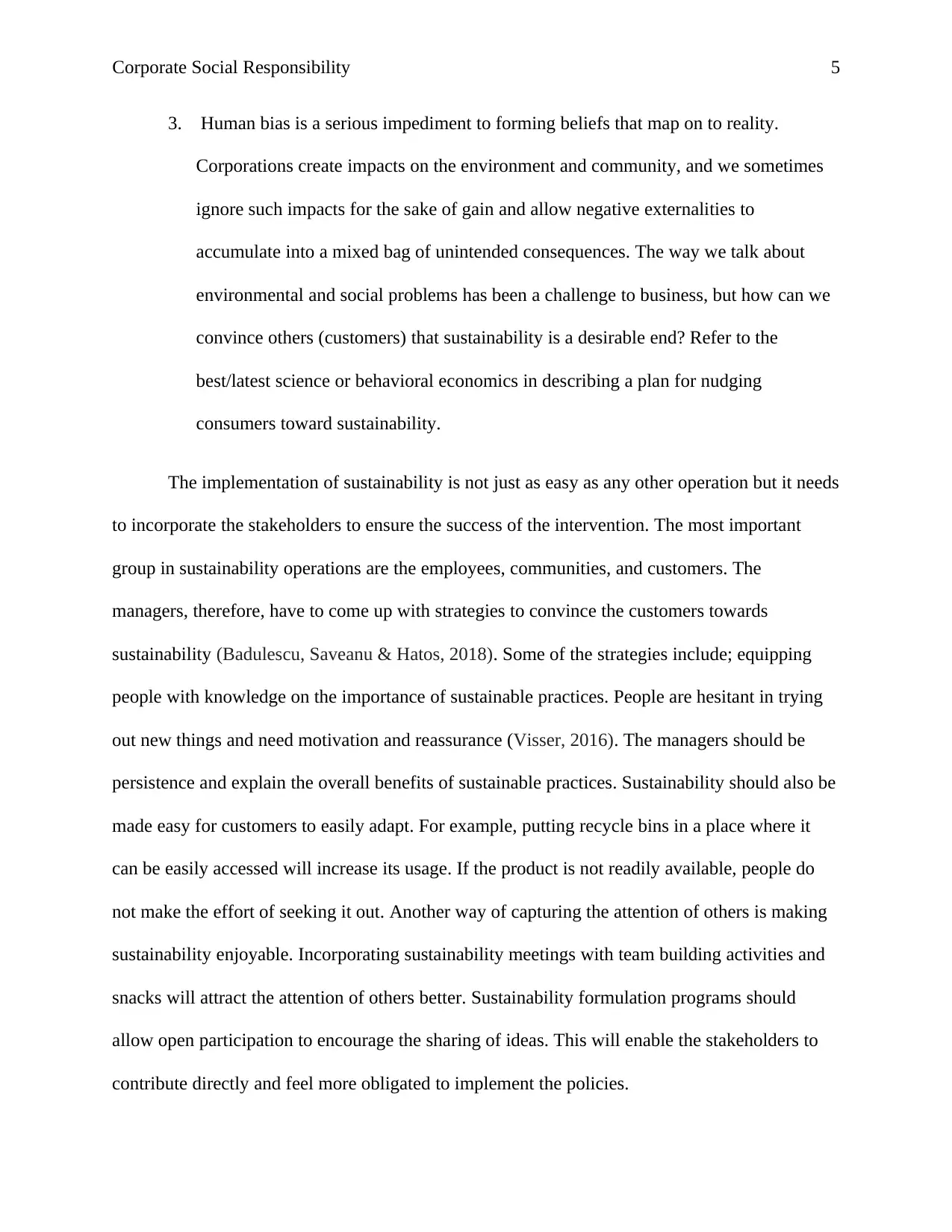
Corporate Social Responsibility 5
3. Human bias is a serious impediment to forming beliefs that map on to reality.
Corporations create impacts on the environment and community, and we sometimes
ignore such impacts for the sake of gain and allow negative externalities to
accumulate into a mixed bag of unintended consequences. The way we talk about
environmental and social problems has been a challenge to business, but how can we
convince others (customers) that sustainability is a desirable end? Refer to the
best/latest science or behavioral economics in describing a plan for nudging
consumers toward sustainability.
The implementation of sustainability is not just as easy as any other operation but it needs
to incorporate the stakeholders to ensure the success of the intervention. The most important
group in sustainability operations are the employees, communities, and customers. The
managers, therefore, have to come up with strategies to convince the customers towards
sustainability (Badulescu, Saveanu & Hatos, 2018). Some of the strategies include; equipping
people with knowledge on the importance of sustainable practices. People are hesitant in trying
out new things and need motivation and reassurance (Visser, 2016). The managers should be
persistence and explain the overall benefits of sustainable practices. Sustainability should also be
made easy for customers to easily adapt. For example, putting recycle bins in a place where it
can be easily accessed will increase its usage. If the product is not readily available, people do
not make the effort of seeking it out. Another way of capturing the attention of others is making
sustainability enjoyable. Incorporating sustainability meetings with team building activities and
snacks will attract the attention of others better. Sustainability formulation programs should
allow open participation to encourage the sharing of ideas. This will enable the stakeholders to
contribute directly and feel more obligated to implement the policies.
3. Human bias is a serious impediment to forming beliefs that map on to reality.
Corporations create impacts on the environment and community, and we sometimes
ignore such impacts for the sake of gain and allow negative externalities to
accumulate into a mixed bag of unintended consequences. The way we talk about
environmental and social problems has been a challenge to business, but how can we
convince others (customers) that sustainability is a desirable end? Refer to the
best/latest science or behavioral economics in describing a plan for nudging
consumers toward sustainability.
The implementation of sustainability is not just as easy as any other operation but it needs
to incorporate the stakeholders to ensure the success of the intervention. The most important
group in sustainability operations are the employees, communities, and customers. The
managers, therefore, have to come up with strategies to convince the customers towards
sustainability (Badulescu, Saveanu & Hatos, 2018). Some of the strategies include; equipping
people with knowledge on the importance of sustainable practices. People are hesitant in trying
out new things and need motivation and reassurance (Visser, 2016). The managers should be
persistence and explain the overall benefits of sustainable practices. Sustainability should also be
made easy for customers to easily adapt. For example, putting recycle bins in a place where it
can be easily accessed will increase its usage. If the product is not readily available, people do
not make the effort of seeking it out. Another way of capturing the attention of others is making
sustainability enjoyable. Incorporating sustainability meetings with team building activities and
snacks will attract the attention of others better. Sustainability formulation programs should
allow open participation to encourage the sharing of ideas. This will enable the stakeholders to
contribute directly and feel more obligated to implement the policies.
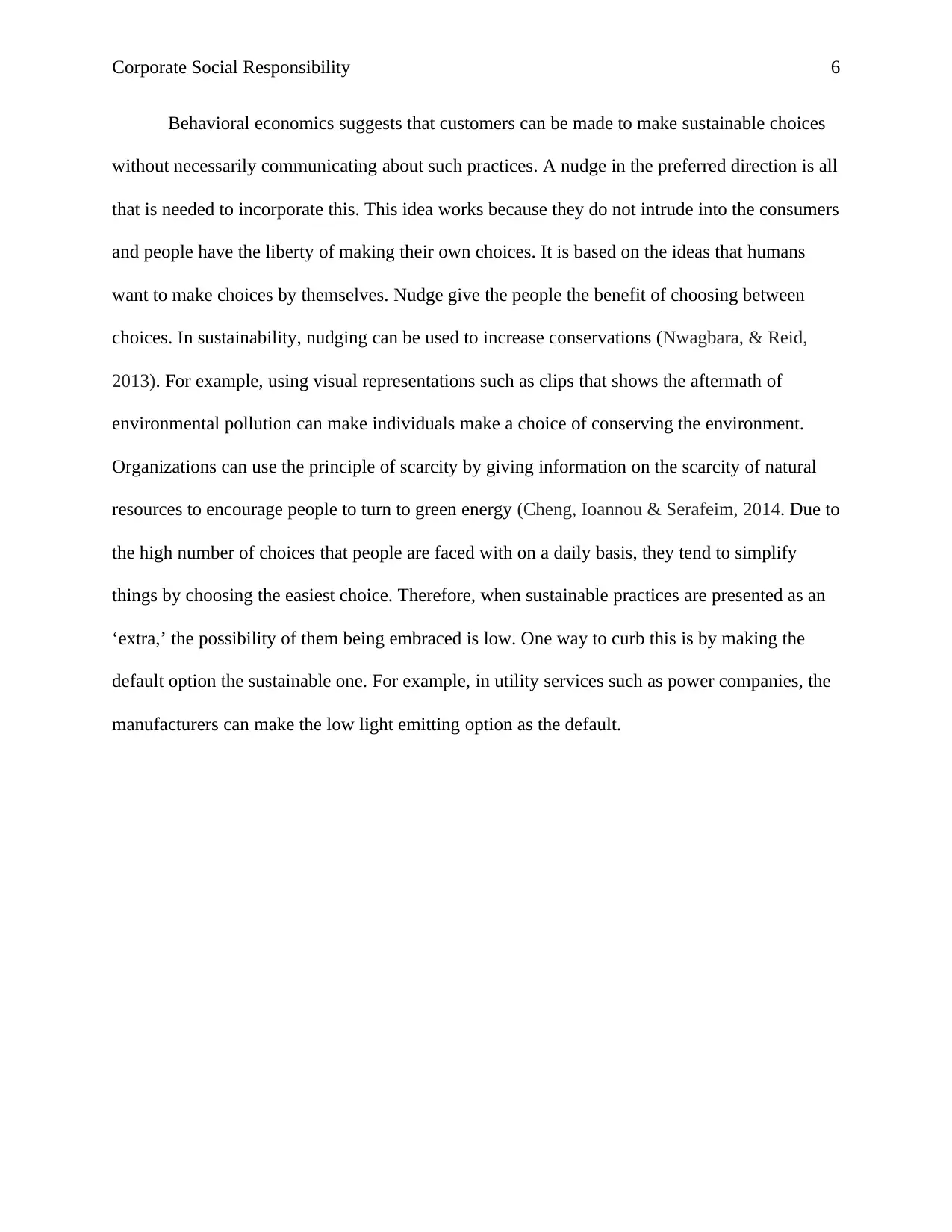
Corporate Social Responsibility 6
Behavioral economics suggests that customers can be made to make sustainable choices
without necessarily communicating about such practices. A nudge in the preferred direction is all
that is needed to incorporate this. This idea works because they do not intrude into the consumers
and people have the liberty of making their own choices. It is based on the ideas that humans
want to make choices by themselves. Nudge give the people the benefit of choosing between
choices. In sustainability, nudging can be used to increase conservations (Nwagbara, & Reid,
2013). For example, using visual representations such as clips that shows the aftermath of
environmental pollution can make individuals make a choice of conserving the environment.
Organizations can use the principle of scarcity by giving information on the scarcity of natural
resources to encourage people to turn to green energy (Cheng, Ioannou & Serafeim, 2014. Due to
the high number of choices that people are faced with on a daily basis, they tend to simplify
things by choosing the easiest choice. Therefore, when sustainable practices are presented as an
‘extra,’ the possibility of them being embraced is low. One way to curb this is by making the
default option the sustainable one. For example, in utility services such as power companies, the
manufacturers can make the low light emitting option as the default.
Behavioral economics suggests that customers can be made to make sustainable choices
without necessarily communicating about such practices. A nudge in the preferred direction is all
that is needed to incorporate this. This idea works because they do not intrude into the consumers
and people have the liberty of making their own choices. It is based on the ideas that humans
want to make choices by themselves. Nudge give the people the benefit of choosing between
choices. In sustainability, nudging can be used to increase conservations (Nwagbara, & Reid,
2013). For example, using visual representations such as clips that shows the aftermath of
environmental pollution can make individuals make a choice of conserving the environment.
Organizations can use the principle of scarcity by giving information on the scarcity of natural
resources to encourage people to turn to green energy (Cheng, Ioannou & Serafeim, 2014. Due to
the high number of choices that people are faced with on a daily basis, they tend to simplify
things by choosing the easiest choice. Therefore, when sustainable practices are presented as an
‘extra,’ the possibility of them being embraced is low. One way to curb this is by making the
default option the sustainable one. For example, in utility services such as power companies, the
manufacturers can make the low light emitting option as the default.
⊘ This is a preview!⊘
Do you want full access?
Subscribe today to unlock all pages.

Trusted by 1+ million students worldwide
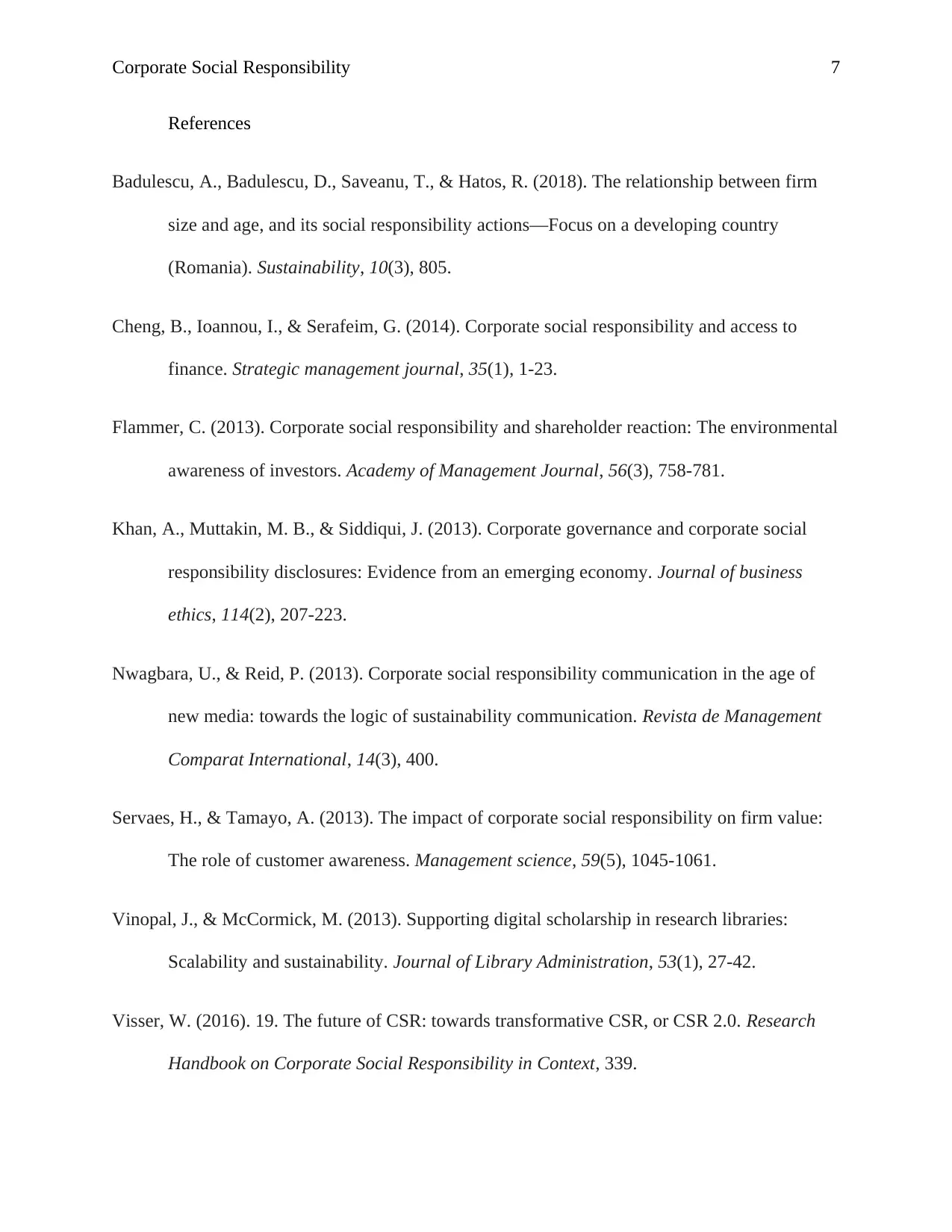
Corporate Social Responsibility 7
References
Badulescu, A., Badulescu, D., Saveanu, T., & Hatos, R. (2018). The relationship between firm
size and age, and its social responsibility actions—Focus on a developing country
(Romania). Sustainability, 10(3), 805.
Cheng, B., Ioannou, I., & Serafeim, G. (2014). Corporate social responsibility and access to
finance. Strategic management journal, 35(1), 1-23.
Flammer, C. (2013). Corporate social responsibility and shareholder reaction: The environmental
awareness of investors. Academy of Management Journal, 56(3), 758-781.
Khan, A., Muttakin, M. B., & Siddiqui, J. (2013). Corporate governance and corporate social
responsibility disclosures: Evidence from an emerging economy. Journal of business
ethics, 114(2), 207-223.
Nwagbara, U., & Reid, P. (2013). Corporate social responsibility communication in the age of
new media: towards the logic of sustainability communication. Revista de Management
Comparat International, 14(3), 400.
Servaes, H., & Tamayo, A. (2013). The impact of corporate social responsibility on firm value:
The role of customer awareness. Management science, 59(5), 1045-1061.
Vinopal, J., & McCormick, M. (2013). Supporting digital scholarship in research libraries:
Scalability and sustainability. Journal of Library Administration, 53(1), 27-42.
Visser, W. (2016). 19. The future of CSR: towards transformative CSR, or CSR 2.0. Research
Handbook on Corporate Social Responsibility in Context, 339.
References
Badulescu, A., Badulescu, D., Saveanu, T., & Hatos, R. (2018). The relationship between firm
size and age, and its social responsibility actions—Focus on a developing country
(Romania). Sustainability, 10(3), 805.
Cheng, B., Ioannou, I., & Serafeim, G. (2014). Corporate social responsibility and access to
finance. Strategic management journal, 35(1), 1-23.
Flammer, C. (2013). Corporate social responsibility and shareholder reaction: The environmental
awareness of investors. Academy of Management Journal, 56(3), 758-781.
Khan, A., Muttakin, M. B., & Siddiqui, J. (2013). Corporate governance and corporate social
responsibility disclosures: Evidence from an emerging economy. Journal of business
ethics, 114(2), 207-223.
Nwagbara, U., & Reid, P. (2013). Corporate social responsibility communication in the age of
new media: towards the logic of sustainability communication. Revista de Management
Comparat International, 14(3), 400.
Servaes, H., & Tamayo, A. (2013). The impact of corporate social responsibility on firm value:
The role of customer awareness. Management science, 59(5), 1045-1061.
Vinopal, J., & McCormick, M. (2013). Supporting digital scholarship in research libraries:
Scalability and sustainability. Journal of Library Administration, 53(1), 27-42.
Visser, W. (2016). 19. The future of CSR: towards transformative CSR, or CSR 2.0. Research
Handbook on Corporate Social Responsibility in Context, 339.
Paraphrase This Document
Need a fresh take? Get an instant paraphrase of this document with our AI Paraphraser
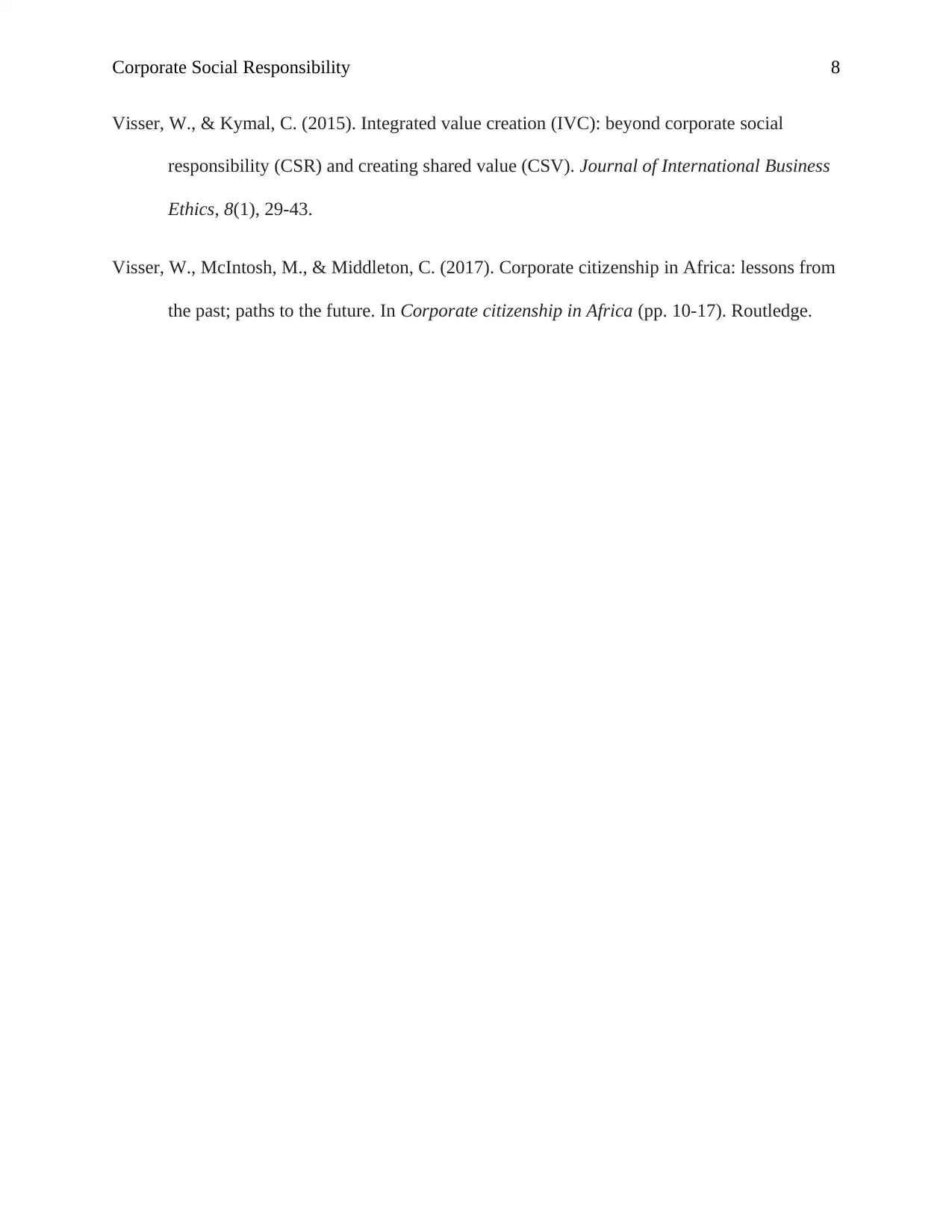
Corporate Social Responsibility 8
Visser, W., & Kymal, C. (2015). Integrated value creation (IVC): beyond corporate social
responsibility (CSR) and creating shared value (CSV). Journal of International Business
Ethics, 8(1), 29-43.
Visser, W., McIntosh, M., & Middleton, C. (2017). Corporate citizenship in Africa: lessons from
the past; paths to the future. In Corporate citizenship in Africa (pp. 10-17). Routledge.
Visser, W., & Kymal, C. (2015). Integrated value creation (IVC): beyond corporate social
responsibility (CSR) and creating shared value (CSV). Journal of International Business
Ethics, 8(1), 29-43.
Visser, W., McIntosh, M., & Middleton, C. (2017). Corporate citizenship in Africa: lessons from
the past; paths to the future. In Corporate citizenship in Africa (pp. 10-17). Routledge.
1 out of 8
Related Documents
Your All-in-One AI-Powered Toolkit for Academic Success.
+13062052269
info@desklib.com
Available 24*7 on WhatsApp / Email
![[object Object]](/_next/static/media/star-bottom.7253800d.svg)
Unlock your academic potential
Copyright © 2020–2025 A2Z Services. All Rights Reserved. Developed and managed by ZUCOL.



